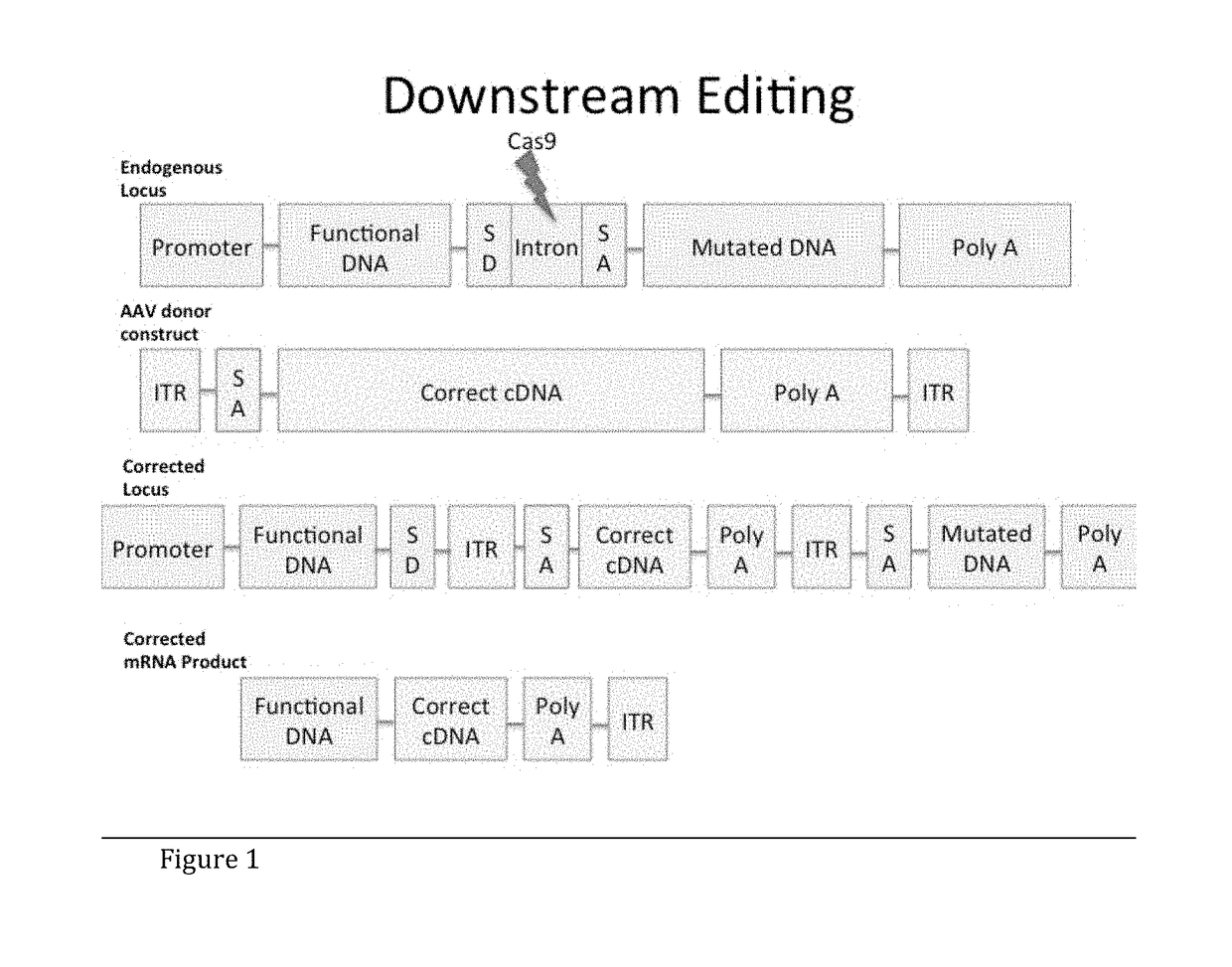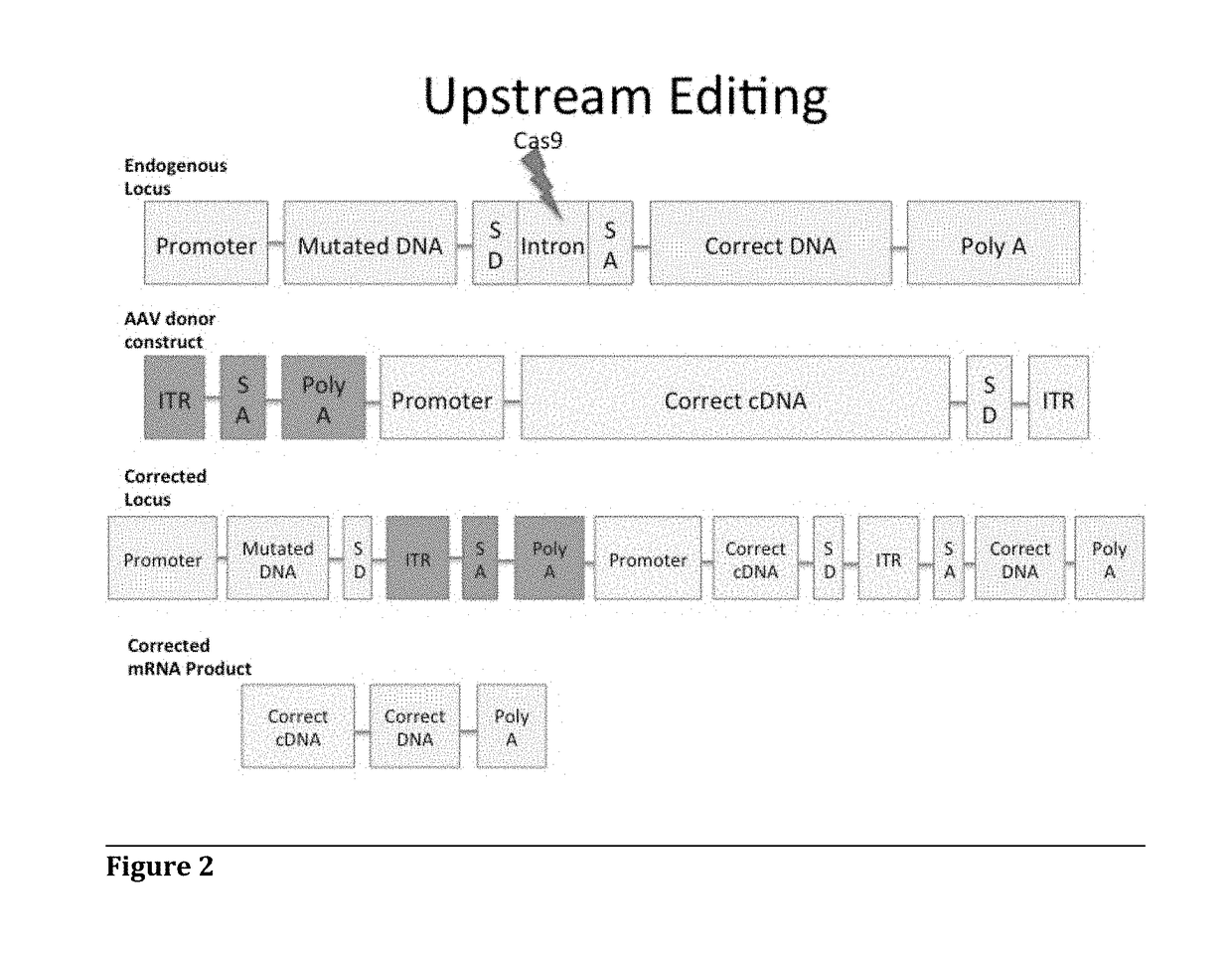Adeno-Associated Virus-Mediated CRISPR-Cas9 Treatment of Ocular Disease
a technology of adenovirus and crisprcas9, which is applied in the direction of viruses/bacteriophages, drug compositions, peptides/protein ingredients, etc., to achieve the effect of reversing blindness
- Summary
- Abstract
- Description
- Claims
- Application Information
AI Technical Summary
Benefits of technology
Problems solved by technology
Method used
Image
Examples
example 1
The Example is a Proposed Strategy for Correction / Replacement of a Target Gene.
[0071]To target oversized loci, for example the ABCA4 locus (certain mutations of which result in Stargardt Disease), perform in vitro cleavage of endogenous ABCA4 locus in HEK 293. First, transfect HEK 293 cells with tandem Cas9 / gRNA construct targeting intron 16 of ABCA4. Then, detect specific cleavage with Celase I Surveyor Mutagenesis assay (run gel to detect cleavage).
[0072]For correction of oversized target genes, for example ABCA4, stably transfect HEK 293 cells with ABCA4 cDNA (or any future target cDNA greater than 4.8 kb using a similar strategy) including intron 16 between exons 16 and 17, upstream of the major mutations (or relevant region of other oversized targets). Intron 16 is targeted with a Flag-tagged cDNA construct with a Splice Acceptor and exons 17-50. Correction is then verified by co-immunoprecipitation and Western blot on ABCA4 (or any future target protein) and Flag protein.
example 2
The Example is a Proposed Strategy for Cleavage of Endogenous Oversized or Disease-Causing Gene Loci.
[0073]To target oversized loci, for example the ABCA4 locus (certain mutations of which result in Stargardt Disease), perform in vitro cleavage of endogenous ABCA4 locus in HEK 293 cells in vitro. First, transfect HEK 293 cells in culture with tandem Cas9 / gRNA plasmid construct targeting intron16 of ABCA4. Then, detect specific cleavage with Celase I Surveyor Mutagenesis assay, to detect the frequency of cleavage events at that site. This study will show proof of concept for targeting either oversized loci for cleavage and gene insertion or disruption of mutated gene loci that lead to harmful pathology with specifically designed Cas9 / gRNA DNA.
[0074]In another example, package the above Cas9 and gRNA plasmid(s) into AAV vectors. Transduce HEK 293 cells in culture with AAV construct(s) targeting intron 16 of ABCA4, and detect site-specific cleavage with Celase I Surveyor Mutagenesis as...
example 3
The Example is a Proposed Strategy for Correction of Endogenous Oversized Loci:
[0075]For correction of oversized target genes, for example ABCA4, stably transfect HEK 293 cells with ABCA4 cDNA (or any future target cDNA greater than 4.8 kb using a similar strategy) including intron 16 between exons 16 and 17, upstream of some of the major mutations in Stargardt Disease (or relevant region of other oversized targets). Target intron 16 with a Cas9 / gRNA construct for cleavage, and transfect a flag-tagged cDNA construct with a Splice Acceptor and exons 17-50 of ABCA4 for insertion into the cleaved intron. Verify correction by co-immunoprecipitation and Western blot on ABCA4 (or any future target protein) and Flag protein.
Abbreviations
[0076]
AAV Adeno-associated Virus Cas CRISPR-associated protein Cas9 CRISPR-associated protein 9 cDNA Complementary DNA CMV Cytomegalovirus CRISPR Clustered regularly interspaced short palindromic repeats DNA Deoxyribonucleic Acid HEK 293 Human Embryonic Kid...
PUM
| Property | Measurement | Unit |
|---|---|---|
| length | aaaaa | aaaaa |
| nucleic acid | aaaaa | aaaaa |
| stability | aaaaa | aaaaa |
Abstract
Description
Claims
Application Information
 Login to View More
Login to View More - R&D
- Intellectual Property
- Life Sciences
- Materials
- Tech Scout
- Unparalleled Data Quality
- Higher Quality Content
- 60% Fewer Hallucinations
Browse by: Latest US Patents, China's latest patents, Technical Efficacy Thesaurus, Application Domain, Technology Topic, Popular Technical Reports.
© 2025 PatSnap. All rights reserved.Legal|Privacy policy|Modern Slavery Act Transparency Statement|Sitemap|About US| Contact US: help@patsnap.com


